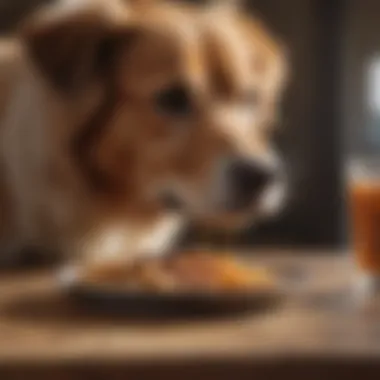Understanding Foods That Trigger Diarrhea in Dogs


Intro
Understanding the dietary factors that can lead to diarrhea in dogs is crucial for every responsible pet owner. Diarrhea can be a symptom of underlying health issues, but often it is linked directly to what a dog eats. Some foods are not only harmful but can disrupt the delicate balance of a dog's digestive system. Knowing what these foods are is important for maintaining your dog's overall health.
In this article, we will explore common foods that trigger gastrointestinal upset in dogs, the signs of food intolerance, and practices for safely introducing new diets. By understanding these aspects, dog owners can make informed choices to enhance their pet’s well-being.
Understanding Your Pet
Breed Traits
Different breeds have unique dietary needs. For instance, small breeds like Chihuahuas may have sensitive stomachs and can react negatively to rich or new foods. On the other hand, larger breeds, such as Labrador Retrievers, often have robust digestive systems but can also experience diarrhea from sudden changes in diet. Being aware of these traits can help owners optimize their dog's diet and avoid problematic foods.
Common Temperaments
A dog's temperament can influence its eating habits. Some dogs are more prone to eating too quickly, leading to digestive issues, including diarrhea. Watching your dog’s behavior during meal times is a good practice. If your dog tends to devour food rapidly, consider feeding smaller, more frequent meals or using a slow-feed bowl to promote better digestion.
Special Needs
Age, weight, and health conditions are also significant factors. Puppies, for instance, have developing digestive systems and require special consideration when introducing new foods. Senior dogs may have dietary restrictions that necessitate a different approach to food. Special needs pets are often more susceptible to food-related digestive issues and should be monitored closely.
Pet Care Essentials
Nutrition and Feeding Guidelines
A balanced diet is a cornerstone of your pet's health. High-quality dog food that aligns with your dog's life stage is essential. Ingredients like grains, dairy, and certain proteins may cause diarrhea in some dogs. Reading labels carefully and choosing foods without fillers or artificial additives can reduce the risk of gastrointestinal upset.
- Avoid feeding dogs:
- Rich or fatty treats
- Dairy products for lactose-intolerant dogs
- Human food, especially spicy or greasy items
Grooming Tips and Techniques
While grooming may not directly relate to diet, overall hygiene can impact digestive health. Regular brushing not only promotes healthy skin but can also reduce the likelihood of hair ingestion, which can contribute to digestive disturbances.
Health and Wellness
Regular vet check-ups are essential to monitor your dog's health. Discuss any changes in your dog’s digestive habits with a veterinarian. They can provide tailored advice based on individual needs and suggest dietary adjustments or specific probiotics if necessary.
Training and Behavior
Basic Training Techniques
Positive reinforcement training is effective in teaching your dog not to consume inappropriate items. This not only helps manage their behavior but can also prevent them from getting into harmful food sources.
Behavioral Problems and Solutions
If your dog displays signs of chronic diarrhea, identifying triggers is paramount. Keeping a food diary can help correlate diet with symptoms. If a particular food consistently causes issues, it should be removed from their diet.
Mental Stimulation Activities
Engaging your dog mentally can sometimes reduce anxiety-related digestive issues. Puzzle toys or training exercises can keep them occupied and less likely to eat indiscriminately or consume things they shouldn’t.
Engaging with Your Pet
Interactive Games and Toys
Playing interactive games not only strengthens your bond with your pet but can also serve as a distraction from harmful eating behaviors. Keep their focus on approved treats and play rather than on scavenging for forbidden foods.
Safe Outdoor Activities
When exploring outdoors, ensure your dog does not eat plants or other animals that could upset their digestion. A leash or harness can help you monitor their food intake effectively.
Family-Friendly Pet Interactions
Educating family members about safe feeding practices is key. Ensuring that everyone knows not to share harmful foods will help maintain consistency and reduce potential digestive distress in your dog.


Pet Adoption and Integration
Choosing the Right Pet for Your Lifestyle
When adopting, consider the dietary needs of different breeds. Assessing potential food sensitivities can go a long way in ensuring a harmonious relationship between you and your future dog.
Preparing Your Home for a New Pet
Before bringing a new dog home, it’s important to clear away foods that may pose a risk to their health. Make sure all harmful items are out of reach.
Tips for Smooth Prelude
When introducing new foods, do so gradually. Mixing the new food with existing ones allows your dog’s digestive system to acclimate, minimizing the chance of diarrhea.
Prologue to Canine Digestive Health
Understanding canine digestive health is fundamental for any dog owner. A dog’s digestive system is complex and works in a delicate balance. Any disruption in this balance may lead to various health issues, including diarrhea. This section aims to elucidate that balance and how diet plays an integral role in maintaining it.
Overview of Dog Digestion
The digestive process in dogs begins in the mouth, where food is broken down by chewing and saliva. From there, it moves to the stomach, where it is further digested by acids and enzymes. The intestines play a crucial role in nutrient absorption. In the small intestine, digestive enzymes break down the food into absorbable components. Any unabsorbed material then proceeds to the large intestine, where water is extracted and waste is formed.
Each part of this process is essential. If a component of the digestive system is not functioning properly, it can lead to gastrointestinal issues. Diarrhea is often an indication that something has gone wrong in this process.
Importance of Diet in Canine Health
Diet is a pivotal factor in a dog's health. A well-balanced diet promotes not just a healthy digestive system but overall wellbeing. Certain foods can cause disturbances in digestion. These disturbances can lead to symptoms such as diarrhea, often indicating a food intolerance or sensitivity.
Moreover, the quality of ingredients matters. High-quality sources of protein, carbohydrates, and fats should be prioritized. Processed foods and fillers can exacerbate digestive issues. Therefore, understanding what constitutes a balanced diet for your dog is essential. The choice of ingredients directly influences both immediate and long-term health outcomes.
In summation, grasping the fundamentals of canine digestion, combined with informed dietary choices, forms the cornerstone for maintaining optimal canine health. This section sets the stage for comprehending how specific foods can lead to typical issues like diarrhea.
Common Foods That Cause Diarrhea in Dogs
Dairy Products
Many dogs have difficulty digesting dairy products. Lactose is the main sugar found in milk, and many dogs lack sufficient lactase, the enzyme needed to break it down. This inability can lead to diarrhea after consuming milk, cheese, or yogurt. As a general rule, it is wise to limit dairy snacks or treats for dogs.
Fatty Foods
Fatty foods can be hard for dogs to digest. Foods high in fat, such as bacon or fried foods, can lead to gastrointestinal upset. Pancreatitis, which is inflammation of the pancreas, may occur after eating fatty substances, resulting in severe pain and diarrhea. Keeping a dog's diet low in fat is beneficial for their digestive system.
Certain Vegetables
Some vegetables can also be harmful to dogs. Certain types are particularly well-known for leading to digestive issues, such as:
Onions
Onions are toxic to dogs. They contain compounds that can damage red blood cells, leading to anemia. Consuming even small amounts can cause gastrointestinal upset, including diarrhea. Owners should strictly avoid feeding their dogs any foods that contain onions, whether cooked or raw.
Garlic
Garlic, much like onions, is harmful to dogs. It has similar compounds that can disrupt red blood cells. Garlic is frequently found in various foods or as a seasoning and should be avoided in a dog's diet. Symptoms of garlic toxicity can include nausea and diarrhea.
Avocados
Avocados contain a substance called persin, which can be toxic to dogs in high amounts. While the pulp contains less persin than the pit or skin, it can still cause upset stomach, leading to diarrhea. Pet owners should avoid giving avocados to their dogs to prevent potential digestive issues.
Fruits and Their Effects
Certain fruits can also trigger diarrhea. Even if some fruits are healthy, for dogs, they might not always have a beneficial impact:
Grapes
Grapes are highly dangerous for dogs as they can lead to kidney failure. Despite their health benefits for humans, mothers must be cautious and avoid giving grapes to dogs. Even a small amount might result in diarrhea or other gastrointestinal issues.


Raisins
Raisins are similar to grapes and are equally toxic. This dried fruit can cause severe digestive problems. Consumption can lead to symptoms like vomiting and diarrhea. It's important to keep raisins away from dogs entirely.
Citrus Fruits
Citrus fruits, such as oranges and lemons, can upset a dog's stomach. The acidity in these fruits can cause digestive disturbances. While not as dangerous as grapes or raisins, they are best avoided to maintain digestive health.
Processed Foods
Processed foods often contain preservatives, artificial flavors, and additives that can be harmful to dogs. Many dogs struggle to digest these unnatural ingredients, leading to diarrhea. Therefore, it is advisable to provide dogs with fresh, whole foods whenever possible.
Human Snacks and Treats
Human snacks can be attractive to dogs but may cause serious digestive issues. Foods like chips or cookies contain salt, sugar, and other additives that are unhealthy for dogs. Consuming these foods may lead to gastrointestinal upset, including diarrhea.
Nuts and Nut Products
Some nuts can be very harmful to dogs:
Macadamia Nuts
Macadamia nuts are particularly toxic for dogs. They can cause weakness, elevated temperature, and diarrhea after ingestion. Pet owners must ensure these nuts are not within reach of their pets.
Peanut Butter (with xylitol)
Peanut butter can be a great treat unless it contains xylitol. This artificial sweetener is extremely toxic to dogs. It can result in insulin surges leading to organ failure. Pet owners should read labels carefully before giving any peanut butter to dogs.
Symptoms of Dietary Intolerance
Understanding the symptoms of dietary intolerance is crucial for dog owners to ensure their pets' health and comfort. Recognizing these signs can lead to timely interventions that prevent further health complications. Dogs can be sensitive to various foods, and knowing the specific symptoms can aid in identifying problematic ingredients. This section aims to illustrate the symptoms that may arise when a dog encounters difficulty digesting certain foods, providing clarity for responsible pet ownership.
Signs of Diarrhea
Diarrhea is one of the most obvious indicators of dietary intolerance in dogs. Owners should be vigilant when observing any changes in their dog's bowel movements. Signs of diarrhea include:
- Loose, watery stools: This is the primary sign. Loose stools can indicate irritation in the gastrointestinal tract.
- Frequent defecation: Dogs may need to relieve themselves more often than usual.
- Straining to defecate: If a dog is struggling to pass stool, it may suggest discomfort or blockage.
- Presence of blood or mucus in stools: Any noticeable change in color or consistency should prompt concern.
It is essential for pet owners to track their dog’s bowel habits. A simple diary can help determine patterns related to food intake and digestive issues. By correlating the introduction of new foods with incidences of diarrhea, owners can identify which specific items trigger distress.
Additional Digestive Disturbances
In addition to diarrhea, dogs may exhibit further symptoms related to dietary intolerance. Two notable disturbances include vomiting and abdominal pain.
Vomiting
Vomiting is another critical symptom to monitor. It can occur as the body attempts to rid itself of something harmful. The key characteristic of vomit is its indication of a deeper issue. When a dog vomits, it shows that the digestive system is distressed. This symptom is particularly relevant because it can reinforce the idea that the dog's dietary choices need reconsideration.
- Unique feature: Vomiting can also signal potential poisoning or severe digestive upset. This highlights the need for immediate action in consultation with a veterinarian.
- Advantages: It can serve as a beneficial warning sign, alerting the owner that something is amiss and encouraging prompt attention to diet and health.
Abdominal Pain
Abdominal pain often manifests in dogs through expressions of discomfort such as whining, reduced appetite, or a reluctance to engage in physical activity. Dogs may also adopt unusual positions, such as lying down with their abdomen tense. This symptom is indicative of possible gastrointestinal distress.
- Key characteristic: Dogs experiencing abdominal pain may seem more sensitive to touch around the stomach area.
- Unique feature: If left unaddressed, abdominal pain can lead to more serious complications. Recognizing this early can lead to timely veterinary recommendations.
How to Introduce New Foods Safely
Introducing new foods to a dog's diet requires careful consideration. A sudden change can lead to digestive upset, including diarrhea. By taking the right steps, pet owners can minimize risks and promote healthier eating habits for their dogs. This section emphasizes the significance of a gradual transition and attentive monitoring of reactions when incorporating new foods into a canine's diet.
Gradual Transition
A gradual transition is crucial when adding new food to a dog's diet. This process helps their digestive system adjust without overwhelming it. Abrupt changes can lead to gastrointestinal disturbances, such as diarrhea, which can be uncomfortable for dogs.
Here is a basic outline of how to implement a gradual transition:


- Duration: It is recommended to take about 7 to 10 days. This allows sufficient time for adjustment.
- Proportions: Start by mixing a small amount of the new food with the current food. A suggested ratio is 25% new food to 75% old food for the first few days.
- Increase Gradually: Each few days, increase the amount of new food while decreasing the old food. This could follow ratios like 50/50, then 75/25 before fully transitioning.
- Consistency: Keep the feeding times consistent. Changes in schedule can also upset a dog's stomach.
Following this approach can help avoid sudden digestive issues and allows pet owners to monitor their pets for any signs of intolerance or discomfort.
Monitoring Reactions
Monitoring a dog's reactions after changing their diet is very important. Pet owners should observe their dogs for changes in behavior or health. A few signs to watch for include:
- Digestive Upset: Watch for loose stools or vomiting, which may indicate intolerance to the new food.
- Changes in Appetite: A dog that suddenly refuses food may be reacting to a dietary change.
- Behavioral Changes: Any signs of lethargy or discomfort should be noted.
If any adverse reactions occur, it may be necessary to adjust the transition plan. Sometimes, returning to the previous diet is necessary until finding an alternative that suits the dog better.
In summary, introducing new foods safely is a process that involves gradual transition and keen observation. This helps prevent gastrointestinal distress and ensures that the dietary needs of your dog are properly met. Good practices can promote better health and happiness for your pet.
Consulting with a Veterinarian
Seeking the guidance of a veterinarian is crucial for dog owners dealing with issues related to dietary effects on their pets. A veterinarian brings expertise that can help in understanding how certain foods can influence a dog's digestive health. Consulting a professional ensures that a pet owner addresses concerns effectively and safely.
Dog owners may often hesitate to seek veterinary advice, thinking they can manage dietary changes themselves. However, it is essential to realize that some food-related health issues can escalate quickly. A veterinarian can provide not only reassurance but also specific recommendations. This can be particularly beneficial when a dog exhibits persistent diarrhea or other digestive disturbances that do not seem to resolve with basic treatment at home.
When to Seek Professional Advice
There are clear signs when a dog needs veterinary care. If diarrhea lasts more than a day or if it becomes severe, a consultation is warranted. Additional symptoms that warrant professional evaluation include:
- Vomiting
- Lack of appetite
- Lethargy
- Blood in stool
- Abdominal pain or discomfort
These signs may indicate more severe underlying issues that require immediate attention. In these cases, timely intervention can prevent further health complications.
Potential Tests and Examinations
Veterinarians rarely rely on visual assessments alone. They might recommend a series of tests if they suspect a food-related intolerance or dietary issue. Common examinations may include:
- Fecal analysis: To check for parasites or bacteria.
- Blood tests: To evaluate overall health and identify any metabolic issues.
- Allergy tests: These help identify specific food allergies or sensitivities.
- X-rays or ultrasounds: These imaging tests can reveal gastrointestinal issues.
These tests are designed to provide comprehensive insights into a dog's health and tailor an effective dietary plan. Understanding the exact cause behind a dog's digestive issues is key to avoiding future episodes of diarrhea.
Preventative Measures for Dog Owners
Taking proactive steps in preventing diarrhea in dogs is essential for maintaining their overall health. Prevention can often be easier and more effective than treatment. Understanding the nutritional needs of a dog helps in preventing gastrointestinal upset caused by inappropriate food intake. Many owners may not realize that certain ingredients can lead to digestive issues. Therefore, being informed and vigilant is crucial.
Understanding Ingredient Labels
Deciphering ingredient labels on pet food is key to preventing potential digestion problems. The ingredient list can reveal a lot about the nutritional quality of the food you are providing to your dog. Pet owners should look for specific information:
- Whole Ingredients: The first few ingredients should be recognizable and whole foods like chicken, beef, or vegetables. Avoid foods with vague terms like "meat by-products".
- Preservatives and Additives: Some chemical additives can irritate a dog's digestive system. Identifying labels that contain natural preservatives can be beneficial.
- Grain-Free Options: While some dogs tolerate grains, others may react poorly. Knowing your dog’s specific needs can guide you to select the right food.
Paying close attention to these details can mitigate the risk of food-related diarrhea and contribute to better health.
Creating a Balanced Diet
Designing a balanced diet is fundamental in preventing diarrhea. A balanced diet ensures your dog receives all necessary nutrients without overloading their system with unsuitable foods.
- Variety in Protein Sources: Incorporate diverse protein sources, such as chicken, fish, and lamb to keep your dog interested and healthy. Proteins should be of high quality to facilitate digestion.
- Incorporating Vegetables: Some vegetables can be beneficial. Ingredients like sweet potatoes and carrots can promote digestion without causing irritation.
- Probiotic Inclusion: Foods containing probiotics can support gut health. Probiotics help to restore and maintain healthy gut flora, minimizing the chances of digestive upset.
A well-rounded diet promotes digestive stability and supports overall health.
Creating a balanced diet requires knowledge and understanding of what works best for your individual dog. Adjustments may be needed as your dog ages or if their activity level changes. Always observe your dog’s response after changing diets and consult with a veterinarian if digestive issues persist.
The End
In the realm of canine health, understanding the foods that can trigger diarrhea is paramount. This article sheds light on various dietary components, helping pet owners make informed choices. Knowledge of specific food types that may cause gastrointestinal upset not only helps in preventing discomfort for dogs but also in maintaining their overall health.
Recap of Key Points
- Identifying Problematic Foods: We discussed the common categories of foods that can cause diarrhea such as dairy products, fatty foods, and certain vegetables and fruits. Understanding these can greatly help in adjusting your dog’s diet.
- Recognizing Symptoms: It is essential to recognize symptoms of dietary intolerance, such as vomiting and abdominal pain, in addition to diarrhea. Early detection can lead to swift action.
- Strategic Food Introduction: We highlighted ways to safely introduce new foods to your dog. The gradual transition and monitoring for reactions are crucial steps to mitigate the risk of digestive issues.
- Veterinary Consultation: Knowing when to consult with a veterinarian can save a dog from serious health issues. Professional guidance may be required in cases of persistent gastrointestinal distress.
- Preventative Practices: Understanding ingredient labels and creating balanced diets are key to avoiding ingredients that may upset your dog’s stomach.
The Importance of Vigilance
Being vigilant about what your dog consumes is not just a matter of comfort; it speaks to their long-term health. Food sensitivities can evolve over time, making it necessary to continuously evaluate the diet.
"A dog's diet should be treated with as much care as human nutrition."
Regular monitoring of your dog’s response to various foods ensures that you can adjust their meals accordingly. Moreover, maintaining open communication with your veterinarian fosters a proactive approach to canine nutrition. By staying alert and informed, pet owners can ensure their dogs thrive, avoiding the complications associated with dietary indiscretions.



